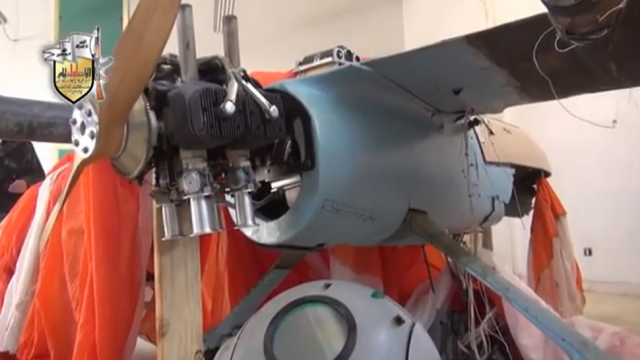 In the latest incident, Syrian rebels have unveiled a reported Pahpad UAS (Persian for “remotely piloted aircraft,” it’s generic like UAS) that they’d shot down/recovered/found maybe. A video on Youtube (since taken down) details the craft’s engine, wings, serial numbers, and FLIR optics turret.
In the latest incident, Syrian rebels have unveiled a reported Pahpad UAS (Persian for “remotely piloted aircraft,” it’s generic like UAS) that they’d shot down/recovered/found maybe. A video on Youtube (since taken down) details the craft’s engine, wings, serial numbers, and FLIR optics turret.
Based on where it was recovered and the build of the machine, many defence analysts are pointing the finger at the Mohajer 4, an Iranian-built, Hezbollah-operated, regime-supported intelligence, surveillance, and reconnaissance UAS with laser-guided strike capabilities.
The Mohajer series of UAS measure between 2.9 and 3.64 meters in length with a roughly 5 meter wingspan and and operational range between 50 and 150 kilometers and a top speed of 120-220 km/h, depending on which of the four Mohajer models you’re looking at.
The Mohajer line was initially developed at the very start of the Iran-Iraq War. In order to gain insights into Iraqi troop movements, Iranian universities and the Iranian Revolutionary Guard designed and built four remote controlled aircraft prototypes in 1981 and immediately pressed into service monitoring the front lines. Over the next 6 years, the prototypes, renamed the Mohajer 1 and equipped with RPG rockets, flew a total of 619 sorites, becoming the first armed UAS ever used in a conflict. The larger second iteration incorporated autopilot capabilities while the Mohajer 3 (aka the Hod Hod) improved the class’ endurance and range. The current Mohajer 4 builds off this success with a redesigned composite body, even better range and operational air time, as well as an upgraded optics package.
Since their implementation three decades ago, Iran has put the Mohajers to good use—monitoring the Afghanistan civil war in the 1990s, selling eight Mohajer 4s to Lebanon’s Hezbollah militia who promptly flew one over Israel in 2004 (just before crashing it into the ocean, schmucks) and again in 2005, and illegally exporting the technology to Venezuela for $28 million (like Chavez gave a shit about international laws) where it became the SANT Arpía. And since the start of the Syrian Civil War, the Mohajers have been hard at work reconnoitring Damascus’ suburbs, coordinating the shelling of rebel towns and breadlines, and basically acting as the nearly untouchable eyes and ears of the regime over enemy-held ground.
“The UAS sends the coordinates to mobile trucks, which send the information to engineers in Damascus who then pass it on to troops on the ground,” an unnamed Lebanese security source told the Global Post.
“Mohajer 4 has a data link and has the ability to downlink imagery in real time. The imagery could be used to provide tactical intelligence to help with artillery spotting and firing to hit a target, such as a building,” confirmed Douglas Barrie, an airpower specialist for the International Institute for Strategic Studies (IISS), “Tactical UAS provide the ability to see what’s going on over the hill in an area you can’t get people on the ground. They give you a persistent stare, to look down and get a view on ground you don’t control.”
Source: Gizmodo
